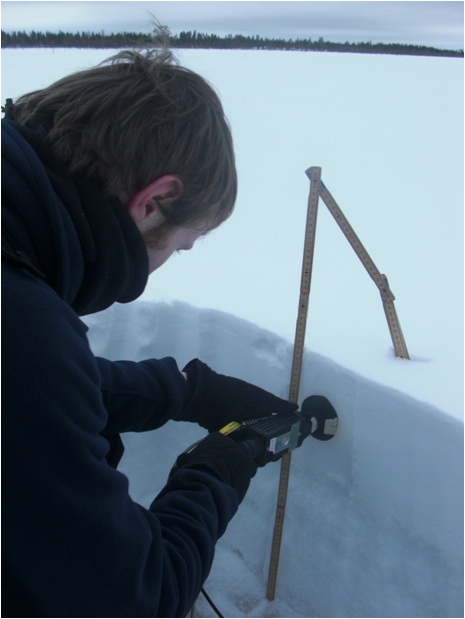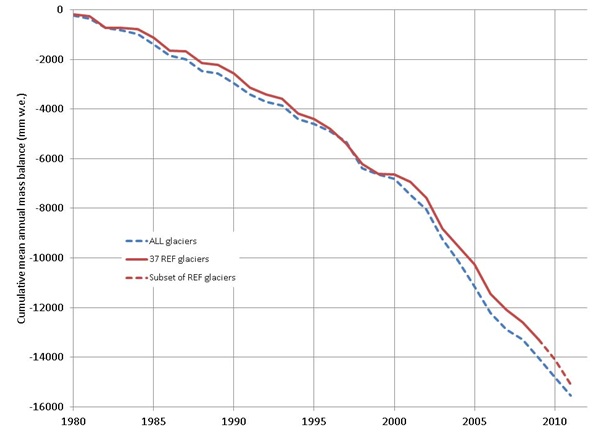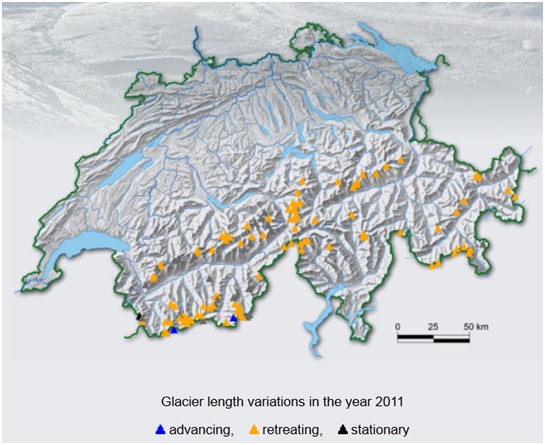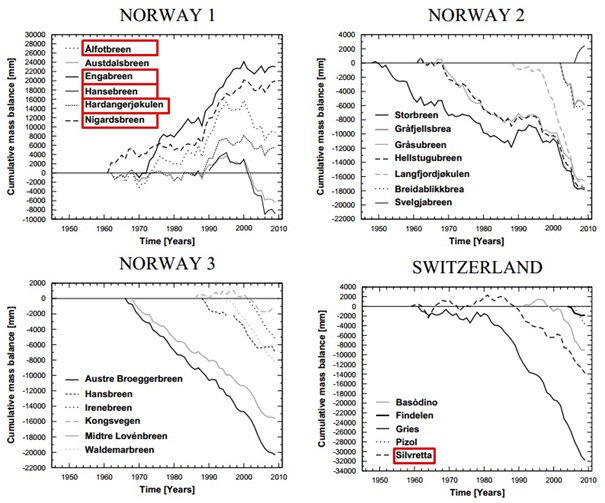Glaciers still shrinking in 2011, how have contrarians claimed the opposite?
Posted on 1 February 2013 by MarkR
Newly released measurements of 100 world glaciers show that 2011 saw the third fastest thinning on record, an average of 80 centimetres (31 inches). This report adds detail to the 500 billion tons a year of ice loss that was seen by the GRACE satellites from 2003-2010, of which 150 billion tons was mountain glacier retreat (Jacob et al, 2012).
We'll get on to the blog & media obsession with growing glaciers later, but first a quick look at the new measurements released by the World Glacier Monitoring Service. They've been looking at glaciers in great detail by getting boots-on-the-ground, scientists who force stakes into the ice and dig pits in the snow for good old-fashioned measurements. As well as being more accurate, these measurements started before satellites even existed (Zemp et al, 2009).

Figure 1 Your author taking measurements in a snowpit in Finland. Snowpits are used to get details about the snow properties, including on glaciers and for predicting avalanches.
The latest update from the World Glacier Monitoring Service
The preliminary measurements show that for this worldwide selection of glaciers, 2011's loss was only beaten by 2003 (when a European heatwave punished Alpine glaciers) and 2006. The change is reported in 'mm water equivalent', which is how deep the water would be if all of the lost ice were melted in place on top of the glacier. Every year since 1984 has seen overall melt, for a total of about 15 metres (49 feet). Last year also confirmed the death of the 18,000 year old Chacaltaya glacier in Bolivia.

Figure 2 Change in total glacier thickness in equivalent water depth for the glaciers measured in detail for the World Glacier Monitoring Service, from 1980-2011.
Most, but not all glaciers are shrinking (the last update found almost 90% were losing weight) and satellites show the overall loss is now 150 billion tons of ice a year. Despite these facts, we regularly see media articles claiming that glaciers are growing; what's going on?
Glaciers overall are shrinking, but tasty cherries trick readers
Cherry-picking is where an author carefully selects only data that agree with them to mislead readers, and you can learn to spot this in blogs and newspapers.
It's very easy to be fooled by the simplest trick: it's where we're shown a handful of stable or growing glaciers as examples that they're fine. There are tens of thousands of glaciers in the world and most measured ones are shrinking. But local weather means that in some years a small number will grow: the Swiss Glacier Monitoring Network reported that Mont Durand glacier grew by 23 metres length in 2011, and the misleading writer will look here. They will forget to report that for that one growing glacier, 92 others in Switzerland shrank, including the Roseg glacier which retreated backwards a staggering 1,305 metres (most retreated by tens of metres). They have turned a story about 92 shrinking glaciers and 1 growing glacier into a story about global warming not being true.

Figure 3 Map of 2011 glacier change in Switzerland(REF). Blue ones are getting longer, yellow ones shorter. There are two blue triangles, but one of those increase (+0.4 metres) is so small that the measurements aren't precise enough to confirm it, so only one is listed as definitely growing.
They make the story sound better by whisking you around the world with different examples, but without saying that for every stable glacier they talk about, there are lots more that are shrinking.
Sound like a ridiculous and deceitful trick? Yes, it does, but it's been tried here and here and here and here and here and elsewhere.
There are other tricks too, and it's much harder to realise that they're being used. Your only defence is to ask yourself where the measurements come from and if you're getting the full details.
As well as just looking at a handful of the glaciers, sometimes the misleading author will only give you certain times as well. For example, in 2011 the US saw slight thickening on average. This might get coverage, but the fact that they're still thinner than 5 years ago because of previous losses will be hidden. Norwegian and Swedish glaciers grew in the 1990s due to changing weather patterns, now they have stopped growing (Nesje et al, 2008, Engelhardt et al, 2010) but some reporters are stuck in the '90s.
Many of web list of 'growing' glaciers are actually shrinking
The hardest trick to spot is where someone says something that isn't true. One blog promises that an ice age is on the way, but to avoid the fact that glaciers are actually shrinking they combine cherry picking with wrong or out-of-date 'facts' of their own.
Overall, measurements show that Greenland is now losing hundreds of billions of tons of ice a year (Shepherd et al, 2013). Warming has meant that the frigid interior has thickened because of heavier snowfall as the warmer air holds more moisture (Johannessen et al, 2005), but that the edges of the ice sheet have been melting so quickly they overwhelm this (Rignot et al, 2008). The real story is that Greenland is losing weight, but this blog isn't alone in saying the opposite.
Various other glaciers that are listed as 'growing' have been shrinking for years: including Norwegian ones like Briksdalsbreen (Nesje et al, 2008), Alfotsbreen (thinner by 8.8 m from 2001-10) and Hansebreen (thinner by 14 m over 2001-10). Engabreen has stablised in thickness, but has been losing area (Kjollmoen et al, 2011)
One of the glaciers listed, Silvretta glacier in Switzerland, has lost length every year since 1984, and has also thinned by 14 metres since then. But it had two years in which it lost area, but thickened slightly, and this is enough for blogs to say that it's growing.

Figure 4 Change in glacier thicknesses measured in Norway and Switzerland since the 1950s. A red box is around the glaciers that were listed as 'growing' by climate skeptics, although all of them are now either stable or shrinking. All of the other glaciers, which are shrinking, were ignored. These 6 were chosen for presentation, but the other 18 shrinking ones were ignored.
Conclusions
The big picture is that most glaciers are shrinking. A small fraction are growing, but for every measured growing glacier there are 9 shrinking ones. 2011 saw the third fastest retreat, and we know that overall glaciers are losing about 150 billion tons of ice a year because of satellite measurements. Stories about growing glaciers are popular on some blogs and newspapers, but they rely on hiding or ignoring 90% of the evidence.































 Arguments
Arguments






























@6 dana
you should be honoured - Mark has done a great job with this one. Was it Oscar Wilde or George Bearnard Shaw who said only 1/4 of the sayings attributided to him were true, but he wished he had actuallly said it?
StB
StBarnabas - it's funny, John Cook used to get credit/blame for my posts all the time, because people assume SkS = John Cook. Now I guess I've written enough stuff here that people are starting to assume other peoples' posts are mine. I don't mind, Mark always writes good stuff, I just don't want to take credit for it!
Just out of interest, is there a general reason why some glaciers are kicking against the trend and growing, or is it a different reason in every case? Either way do we know why?
And thanks for the new comment interface as well, guys—a great improvement.
John Russell:
Every glacier has its own mass balance - so in that context, yes, every one is different. Generalizations are possible, though. Every glacier also is not uniform over its entire extent - net accumulation of mass will occur over part of the glacier, net loss will occur in other parts. Combined with slope and gravity, this is what causes a glacier to flow.
Typically, a glacier will have an accumuation zone and an ablation zone (ablation = losses due to melt, calving, and/or sublimation/evaporation). In a typical mountain glacier, the upper reaches are accumulating mass, the glacier is flowing downhill, and the lower reaches are losing mass. There is a dividing line between the albation and accuulation zone which is significant on an annual scale, but there are also seasonal effects, too.
How a glacier's mass balance responds to a shift in climate depends on the effects in both the ablation and accumulation zones. A warming climate will usually increase losses in the ablation zone where losses are already greated than accumulation. In the accumulation zone, it can depend on just how cold the zone was before. A very cold accumulation zone with little snowfall may see an increase in snowfall and thus an increase in accumulation with little increase (if any) in melt, whereas a warmer accumulation zone may see less snow (and perhaps more rain) and a reduction in accumulation with increased melting.
More melt/calving in the ablation zone combined with less accumulation in the accumulation zone will obviously cause recession. More ablation plus more accumulation - obviously depends on the details, but will cause glacier advance if accumulation overpowers increased ablation.
Keep in mind that this is not a case of "glaciers will be claimed to show global warming effects no matter what they do" - it is clear that the processes are fairly well understood and there is a narrow set of conditions where warming can lead to glaciers growing. The broad, sweeping generalzation is that warmer climates will cause most glaciers to recede.
It is useful to look at the Swiss Glacier Commission results from 2010 when they noted three advancing glaciers (Kaltwasser, Sardona and Trient. all retreated significantly in 201 and had before 2010 so this was more of a blip than a trend. Similarly the one glacier, Mont Durand, that advanced in 2011 had retreated substantially the previous several years. In 2012 Norway reported of the 28 glaciers observed four advanced, but of these only one had advance in 2011 as well. There are a few advancing glaciers that sustain the advance. Of the 200 glaciers I have worked on only one Taku Glacier has a sustained advance, and this is the result of filling in its fjord with sediment and the resulting cessation of calving, like paying off your mortgage, changed its balance Pelto et al (2008).
Thanks for the explanations, Bob and mspelto, that makes sense and helps greatly.
It looks like the denialosphere have missed another good cherry pick, the Stanton Glacier in Montana. When I first skied It in mid September 2007, it was nearly all ice. The last few years,it has been almost entirely firn covered in late September or early October. I can link to pictures and video if anyone is interested.
Don were you there in mid-sept of 2012? the snowpack looked pretty low in satellite imagery of the area.
I skiied it September 18. This line: link would not have been skiable in 2007 (ice and crevices). This; link and this;
Don... With the new WYSIWYG tool you can click the "insert" tab and easily link a URL. Sorry for killing that last link.
@1 Elmo
Amen to that. Their logic seems to mimic a gem of a quote of Homer Simpson`s from some time ago
"Facts are meaningless. You could use facts to prove anything that's even remotely true."
P.S. I like the new comments system
Of course, the contrarians are correct. We are heading into a glacial. (they call it an ice age not realizing that we are in the middle of an ice age that has lasted about 2.5 million years so far). As soon as an interglacial establishes itself, various carbon sinks start to reduce atmospheric Carbon dioxide and we are on the way to another glacial. The only thing they miss is that we have delayed the onset of the next glacial by who knows how much and may well be headed for a period like the carboniferous. Nothing wrong with that if we hadn't evolved our civilizations during an unusually stable period of climate and put a large amount of infrastructure in harms way from rising sea level. Oh! and developed our agriculture to prosper in the present climate regime and allowed our population to rise to use up each advance in food production. Just wait until our climate lurches instead of creeping as we continue to push on the light switch. Thirty or fourty days of stored food and a few years with vast crop failures!! At what point in this sequence will the deniers become convinced. If they are like the creationists - possibly never.
http://mtkass.blogspot.co.nz/2012/02/carbon-sinks.html
Scientists have looked into that. Per Tzedakis et al 2012:
For reference, we are at about ~394 right now…and climbing, so we can be relatively sure the next glacial epoch won't be happening in our lifetimes.
• http://junksciencecom.files.wordpress.com/2012/01/nature-geoscience-ice-age.pdf
But what about further down the road? What happens then? Per Dr Toby Tyrrell (Tyrrell 2007) of the University of Southampton's School of Ocean and Earth Science at the National Oceanography Centre, Southampton:
and
So no ice ages and no Arctic sea ice recovery the next million years...
• http://plankt.oxfordjournals.org/content/30/2/141.full.pdf+html
Also covered by Stoat, here:
• http://scienceblogs.com/stoat/2012/11/09/carbon-dioxide-our-salvation-from-a-future-ice-age/?utm_source=dlvr.it&utm_medium=twitter
Given the radiative imbalance at the TOA is still present and that CO2 levels are still increasing (and that human emissions are not ending anytime soon), it is reasonable to presume that the impacts of a warming planet will increasingly impact the most vulnerable aspects of our remaining cryosphere: the Arctic sea ice (a goner), the Greenland Ice Sheet and the West Antarctic Ice Sheet.
We are, through our own actions, effectively locking-in a world of another 8-12 meters SLR above present. Unless we can magically arrest our emissions and also initiate methods to draw-down atmospheric concentrations of CO2.